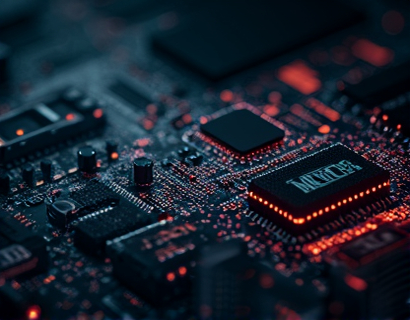DeFi Trading Optimized: Leveraging Advanced Smart Contract AMMs for Enhanced Automation and Liquidity
In the rapidly evolving world of decentralized finance, or DeFi, traders and enthusiasts are constantly seeking ways to enhance their trading experiences. One of the most significant advancements in this space is the integration of advanced smart contract Automated Market Makers (AMMs) that focus on optimizing liquidity management and automating trading strategies. This article delves into how these technologies are reshaping the DeFi landscape, providing a seamless and efficient trading environment for crypto traders.
Understanding AMMs in DeFi
Automated Market Makers, or AMMs, are a cornerstone of decentralized exchanges (DEXs) in the DeFi ecosystem. Unlike traditional order books, AMMs use mathematical formulas and liquidity pools to determine asset prices and execute trades. This approach eliminates the need for order books and traditional market makers, reducing counterparty risk and enhancing liquidity.
In a typical AMM, liquidity providers (LPs) deposit tokens into a pool, and the AMM uses a predefined formula to determine the ratio of tokens in the pool. This formula ensures that the market remains liquid and that trades can be executed smoothly. The most common formula used is the Constant Product Market Maker (CPMM) model, where the product of the quantities of the two tokens in the pool remains constant (x * y = k).
Enhanced Liquidity Management
One of the primary benefits of advanced AMMs is their ability to optimize liquidity management. Traditional DEXs often struggle with liquidity provision, especially for less popular tokens. Advanced AMMs address this issue by implementing dynamic liquidity provision mechanisms and incentivizing LPs with higher returns.
Dynamic liquidity provision allows the AMM to adjust the liquidity pool sizes based on market conditions and trading volume. This flexibility ensures that even lesser-known tokens can maintain sufficient liquidity, making them more accessible to traders. Additionally, some advanced AMMs offer liquidity rewards that are proportional to the risk taken by LPs, further encouraging participation.
Another innovative feature is the use of liquidity aggregators. These protocols pool liquidity from multiple DEXs and AMMs, allowing traders to access a broader range of assets with better liquidity. This aggregation not only enhances the overall liquidity in the DeFi ecosystem but also provides traders with more options and better trading experiences.
Automated Trading Strategies
Automation is a key differentiator of advanced AMMs in DeFi. By integrating smart contracts that execute trading strategies automatically, these platforms enable traders to capitalize on market opportunities without constant monitoring. These automated strategies can range from simple arbitrage to complex algorithmic trading models.
One of the most popular automated strategies is the arbitrage bot, which exploits price discrepancies across different DEXs. Advanced AMMs can detect these discrepancies in real-time and execute trades to profit from the difference. This not only enhances the efficiency of the market but also provides additional returns for LPs.
Another advanced strategy is the use of synthetic assets. Synthetic assets, or synthetic tokens, are digital representations of real-world assets such as stocks, commodities, or other cryptocurrencies. Advanced AMMs can create and manage these synthetic assets, allowing traders to hedge risks or gain exposure to assets that may not be directly available in the DeFi space.
Seamless Market Interactions
The integration of advanced smart contract AMMs significantly improves the user experience in DeFi trading. The automation of trading strategies and liquidity management reduces the need for manual intervention, making the trading process more efficient and less error-prone.
For instance, users can set up automated rebalancing strategies for their portfolios, ensuring that their asset allocations remain optimal without constant monitoring. This feature is particularly useful for long-term investors who want to maintain a diversified portfolio without actively trading.
Moreover, the transparency and immutability of smart contracts enhance trust in the trading process. All transactions and strategy executions are recorded on the blockchain, providing a clear and auditable trail. This transparency is crucial in building confidence among users and fostering a more robust DeFi ecosystem.
Challenges and Considerations
While advanced AMMs offer numerous benefits, there are also challenges and considerations that traders and developers must address. One of the primary concerns is the complexity of smart contracts. Ensuring the security and reliability of these contracts is paramount, as any vulnerabilities can lead to significant losses.
Developers must conduct thorough audits and follow best practices in smart contract development to mitigate these risks. Additionally, the computational costs associated with executing smart contracts can be higher compared to traditional trading platforms. However, advancements in blockchain technology and layer 2 solutions are helping to reduce these costs.
Another consideration is the user interface and accessibility. While the underlying technology is complex, the user experience should remain intuitive and user-friendly. Platforms that focus on simplifying the interaction with advanced AMMs will likely gain more adoption and user satisfaction.
Future Prospects
The future of DeFi trading is bright, with advanced smart contract AMMs playing a pivotal role in its growth. As more developers and projects adopt these technologies, we can expect to see even more innovative features and improvements.
One area of focus will be the integration of machine learning and artificial intelligence to further optimize trading strategies. AI-driven AMMs can analyze vast amounts of market data to identify trends and make more informed trading decisions, enhancing the overall efficiency of the platform.
Additionally, the interoperability between different blockchain networks will become increasingly important. Cross-chain AMMs that allow trading across multiple blockchains will provide traders with unparalleled flexibility and access to a wider range of assets.
Conclusion
Advanced smart contract AMMs are revolutionizing the DeFi trading landscape by optimizing liquidity management and automating trading strategies. These technologies not only enhance the efficiency and accessibility of decentralized trading but also provide robust tools for traders to capitalize on market opportunities.
As the DeFi ecosystem continues to evolve, the role of AMMs will only grow more significant. Traders and enthusiasts should stay informed about these advancements to fully leverage the potential of decentralized finance.











































